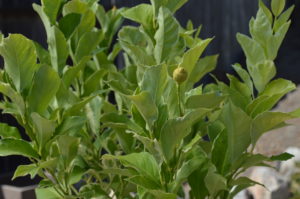Backyard Orchard
A backyard orchard can be brought to fruition in less space than you may think! Many types of fruit trees are available in dwarf forms that you can grow in small gardens or even in patio containers.
There are a number of benefits to growing dwarf trees. You can prune and harvest without getting on a ladder, place container-grown fruit trees on patios and decks, where they are more accessible and easier to care for, to squeeze more fruit trees into a small garden. While many fruit trees do well inc ontainers. learn more about Growing Citrus in Containers here.
Some dwarf varieties are genetic dwarfs—they’ve been bred to be a smaller size. Most, however, are varieties that are selected for superior quality fruit and grafted onto rootstock that has dwarfing characteristics, keeping the trees in a more compact form. Some trees that are labeled “dwarf” will grow to less than 8’ in height; others may grow up to 20’ tall. When selecting your trees, be sure to note the potential height of the specific variety. Learn how to find The Right Tree for the Right Place.
In addition to the size of the tree, you also need to be aware of the USDA hardiness zone and the chill hour requirements. You can check the USDA Plant Hardiness Zone Map to find out the zone number of your location and select a tree that is appropriate for that zone. Chill hours refers to the number of hours when the air temperature is below 45°F. Some trees require a minimum number of chill hours in order to set fruit. Check this chart from the UC Davis Fruit & Nut Research & Information Center to find the number of chill hours recorded in your area and select a tree that requires no more than that amount of chill.
Some tropical or semi-tropical fruit trees, such as guava and some varieties of citrus, are unable to tolerate temperatures below freezing (32°F). If you want to grow these trees in areas that do get below-freezing temperatures, you’ll need to bring the trees inside or provide some kind of protection for them in winter months.
You’ll find deciduous fruit trees, such as apples and plums, in bare-root form in nurseries during the winter months and in containers later in the year. Evergreen fruit trees, such as citrus and avocado, are available in containers, usually year-round.
Materials List:
- Dwarf fruit trees (bare-root or container-grown)
- Pruners
- Shovel
- Mulch
- Containers (Optional)
- Potting soil (Optional)
Steps:
To plant a dwarf fruit tree:
- Prepare the Tree for Planting: Bare-root trees need to be hydrated before planting. Remove any wood chips or sawdust that the roots may have been packed in and soak the roots in a bucket of tepid water for several hours. For container-grown trees, remove the nursery pots and examine the roots. If there are matted roots at the bottom, trim them off and gently loosen the roots at the bottom and edges of the root ball. Learn more about How to Plant a Tree Correctly.
- Scout a Location: Select a location in your yard with at least six hours of direct sun a day and minimal winds.
- Dig a Hole: Dig a hole to the same depth as the tree’s roots and twice as wide. For bare-root trees, mound the soil up at the bottom of the hole so the tree’s roots can be spread out over the mound.
- Plant the Tree: Place the root ball in the hole and fill the soil back in around the roots. Make sure the soil doesn’t cover the crown of the tree or the graft union (the bulging place at the base of the trunk where the tree was grafted). Do not add amendments to the soil at this time. Pack the soil in firmly around the roots to ensure there are no air pockets and add more soil, if needed.
- Top It: Cut the top of bare-root trees back by at least one-third, or as short as 18” above the ground, depending on how low you want the branching to start. This encourages better development of both roots and branches.
- Add Mulch: Spread a 3” layer of mulch around the tree, but not touching the trunk.
- Water Well: Water the tree well and keep evenly moist until established.
- Fertilize Regularly: Feed monthly with a balanced organic fertilizer or a side-dressing of compost during the months that the tree is actually growing (spring and summer). Stop fertilizing deciduous trees in early autumn and through the winter months when the tree is dormant. Begin feeding again when the tree starts to bud. Not familiar with fertilizing? Learn the Fertilizer Basics!
For more information on growing fruit trees, check out the University of California Division of Agriculture and Natural Resources’ web page on The California Backyard Orchard.